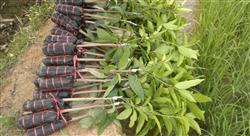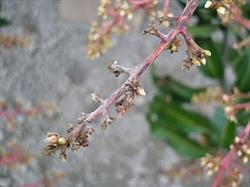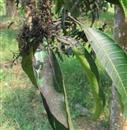How to cultivate the seedlings of pollution-free mango

How to cultivate the seedlings of pollution-free mango? What is the method of pollution-free mango seedling raising method: 1. Seed pretreatment: collect native mango fruits or seeds (polyembryonic varieties), such as Zhanjiang mango, Hainan mango, Guangxi almond mango, Yunnan Xiaomang, Fujian safflower mango, single embryo varieties should be used as species. Remove the pulp of the harvested fruit, rinse it with clean water, and remove the floating water and seeds whose shells are not hard and full. If the seeds are collected from other places, they should be treated in the seed collection land, and the qualified seeds should be exposed to the sun until the seed shell is dry, then moisturized and transported with coconut bran, charcoal powder or fermented wood bran, and the returned seeds will be peeled and germinated according to the local fruit and dried. The seeds used in mango rootstocks should be collected from the edible seeds of mature and full fruits on strong trees. In production, it is also used to process the remaining seeds, or even buy a large number of full fruits to pile up and take the seeds. After the seeds are taken out, the pulp is washed off immediately, dried, and then sown. It should be finished within 7 days, otherwise the germination rate will be affected. Peel off the shell and sprout before sowing. For the dried seeds, clamp the pedicel near the ventral shoulder with a branch shears, twist downward, tear the seed shell along the suture line, and then tear off the seed shell on the other side, the seed can be taken out. two。 Sowing: the shelled seeds can be directly seeded, but the effect is better after budding. The method of sprouting is to first pile a sand bed about 12 cm thick and sprinkle it with water to make the sand bed moist. According to the specification of plant spacing of 1 cm and row spacing of 3 cm and 5 cm, the hilum of the seed is arranged downward on the sand bed of 50% 60% shade, then covered with clean fine sand 1 cm thick and drenched with enough water, and then sprayed once or twice a day to keep the sand bed moist and prevent underground pests. After 20 days, the seeds have basically sprouted. The cotyledons can be divided into different beds before the seedling cotyledons are spreaded. when dividing the beds, they can be transplanted separately according to the size of the seedlings and drenched with fixed root water. To raise seedlings in a nutrition bag, move the seedlings into the bag according to 1 branch of each bag and cover the soil with water. If sowing directly without accelerating germination, it can be directly implanted into a nutrition bag or sowed into the seedbed according to the specification of 18cm × 25cm, and the management can be strengthened later. Ploughing the nursery with a depth of 20 centimeters and smashing the soil. Before ploughing, add calcium superphosphate into the soil before ploughing and apply it to the soil according to the amount of 3000-4000 kg of barnyard manure + 30 kg of calcium superphosphate per 667 square meters. Then the mixed nutrient soil was bagged with a 17 cm × 25 cm nutrition bag, and the bag (polyethylene plastic bag) was buried in the soil and placed according to the row. The width of each row is suitable to hold 6 bags, the length depends on the plot, and the border spacing is 60 cm to 80 cm. 3. Seedling management: the root system of rootstock seedlings is shallow, weak, young tissue, poor stress resistance, vulnerable to diseases and insect pests, so it is necessary to strengthen protection and management. (1) watering: often drench water in case of drought, especially the newly germinated seedlings should be watered every day to keep the seedbed moist, but not stagnant water. (2) shading: the seeds germinate until the seedlings grow, and the cotyledons should be properly shaded before the cotyledons turn green. it is best to use a black shading net with a light transmittance of 50% to 75% on the seedling bed to prevent sunburn of the seedlings. (3) Seedling bed: the survival rate of seedling bed was the highest when the tender buds were just unearthed, the leaves were not yet unfolded, or the leaves were mature for the first time and not out of the second shoot. Because of the two separate beds, there are many lateral roots of the seedlings, and the nutrients stored by the seed embryos can continue to supply the growth of the seedlings, for example, the survival rate is low when the leaves of the first bud are unfolded without turning green or after the second shoot. When dividing the bed, do not hurt the root, even the embryo with root transplanting. Some varieties of a seed can produce several seedlings, to be careful to separate the embryo from the seedling, do not break the endosperm. In order to improve the growth uniformity and survival rate of seedlings, large, medium and small seedlings should be planted separately when transplanting seedlings. Mango seedlings now advocate bag seedlings, because the bag seedlings have a high survival rate and grow fast. The seedlings in separate beds were directly transplanted into nutrition bags, watered and shaded after planting, and then drenched with water every 1-2 days until they survived. (4) Control of diseases and insect pests: the main diseases and insect pests of seedlings are Spodoptera litura and anthracnose. (5) fertilization: after the seedlings survived, they were fertilized once, and then every other month, alternately with 0.5% urea and 1% compound fertilizer. Once every 1.5 months after half a year, can be sprinkled or irrigated after rain, 5kg of urea or 5kg of compound fertilizer is applied every 667 square meters, used alternately. Before the tender shoots turned green, the seedlings were sprayed with trichlorfon 800 ~ 1000 times + carbendazim 200 times or high efficient carbendazim 400 times + methyl topiramate 1000 times every 7 days. Click to get more mango planting techniques click to get more fruit planting techniques
- Prev

How to control mango powdery mildew
How to control mango powdery mildew? Powdery mildew is an important disease in mango flowering, damaging inflorescences, young fruits and young leaves. In China, Guangdong, Hainan, Yunnan, Guangxi and other production areas have occurred. India, Pakistan, Brazil, South Africa, Australia, Sri Lanka and other countries abroad have also been reported. Sickness...
- Next

How to prevent mango soot disease
What's big mango soot? How to control fungal diseases. At present, 6 pathogens causing mango soot disease have been found in China. It damages leaves, branches and fruits, affecting leaf photosynthesis and fruit appearance. Prevention and control methods: one is reasonable dense planting, pruning, keep canopy ventilation and light transmission....
Related
- Moge, come on! The staff of the peasant association in the producing area of cantaloupe were frightened when the crowd gathered.
- Causes and Solutions of low Fruit setting rate of Apple
- Symptoms and control measures of passion fruit virus disease
- Fruit growing lesson: how do apple orchards keep high yields?
- Can you build orchards in the mountains? What are the pros and cons?
- How to manage the coloring period of Crisson grape?
- This paper introduces the processing technology of two kinds of fig products.
- How much is a month for retired teachers in rural areas by 2020?
- How can strawberry planting increase sugar content? We should pay attention to management in many aspects.
- What are the cultivation techniques on how to improve the yield of golden fruit?

